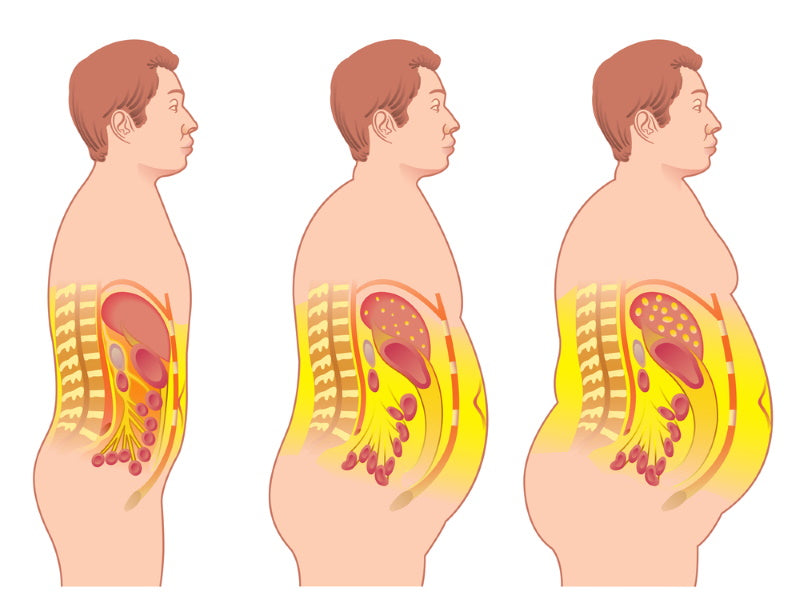Visceral fat seems to play a large factor in your risk for major diseases related to your metabolic function.
While correlation certainly doesn't mean causation 100% of the time, more and more research is pointing to this type of fat as an indication of troubles to come for your health and longevity.
Measure your percent body fat with the Dara Scale.
Visceral Fat vs Subcutaneous Fat

The two main types of stored fat in your body are visceral and subcutaneous.
Visceral adipose tissue is fat stored in your gut surrounding your major organs. Subcutaneous adipose tissue is the fat that is stored between your skin and muscles/bones.
Visceral fat is sometimes labelled as abdominal fat. You can still have subcutaneous fat located between your abdominal muscles and skin, which doesn't count towards visceral adipose tissue and can be labelled belly fat. It has to be below the muscles and surrounding the organs.
Visceral fat is also called active fat since it actively increases health risks for many serious conditions. Subcutaneous fat isn't directly linked to increased risk factors.
While having too much of either type can certainly be a health risk, visceral fat stores seem to be more dangerous and harder to get rid of.

The Beebo Measures Visceral Fat
How Much Of Your Body Fat Is Visceral?
The research points to about 10% of your total body fat are visceral. This means that if you take the total amount of body fat you currently have and multiply it by 0.1, you have a good estimate of your visceral fat storage.
Of course, individual differences come into play, and your metabolic health may affect where excess fat is stored in your body.
Measuring Your Visceral Fat

The FitTrack Scales Show Visceral Fat
Measuring your visceral fat isn't as easy as a skin caliper test to check your subcutaneous fat levels. There are three main measurements:
- CT Scan
- Full-Body MRI (Magnetic Resonance Imaging)
- Waist Circumference Measurements
While a CT scan and MRI are much more accurate than a simple tape measurement, they are typically expensive or unavailable altogether. So, the waist circumference measurement takes its place as a good estimation.
A simple circumference measurement taken at the smallest portion of the abdomen can be an easy test. For women, the at-risk category starts at 35 inches. For men, the at-risk measurement is 40 inches.
If you want to get a little more accurate with the anthropometric measurements, ratios seem to be more effective. The waist-to-hip ratio or the waist-to-height measurement can be utilized.
For waist-to-hip, take your waist measurement and divide it by measuring the widest part of your hips/buttocks. 0.85 is considered at-risk for women, while 0.9 is the mark for men.
For waist-to-height, divide your waist measurement by your height (in inches if you measured your waist in inches). Any ratio greater than 0.5 is considered at-risk. This measurement is considered the most useful and is much more predictive of health risks than your body mass index or BMI.
Reasons For High Visceral Fat
Your body has plenty of complex processes that regulate the storage of excess fatty acids. Obesity is the leading cause of visceral adipose tissue accrual, and undergoing a weight loss plan can typically reverse the damage over time.
Other than that, chronically raised stress hormone cortisol levels have been linked to above-average visceral fat storage. Finding ways to cope with stress and reduce its occurrence is a great way to mitigate this risk.
There seems to be a correlation between women who have undergone menopause and increased risk for visceral fat storage. This may be due to shifting hormone balance, although the exact cause isn't known.
Those who are overweight or obese and live chronically stressed lives are obviously at a much higher risk for fat accumulation throughout your body. There are ways to combat this fat storage, however.
Health Risks Associated With High Visceral Fat
This type of fat has many associated health risks, including:
- Heart Disease
- Insulin Resistance/Type 2 Diabetes
- High Blood Pressure
- Stroke
- High Cholesterol/Lowered HDL
- Alzheimer's
- Chronic Inflammation from raised Cytokines
- Fatty infiltration in the Pancreas
- Decreased Adiponectin in serum
The many risks associated with excess visceral fat should be enough to warrant weight loss efforts through diet and exercise. The health risks are unsurprisingly linked to metabolic syndrome, a catch-all for the disease associated with obesity and a sedentary lifestyle.
The research linking this type of fat and cardiovascular disease is mounting, and preventative measures like weight loss, exercise, and lifestyle changes exist to change course. Yet, heart disease remains one of the top killers in the country!
So, what can we do to reduce excess visceral fat and improve our health and longevity?
Steps To Reduce Visceral Fat
While spot-reducing fat in our abdominal cavity sounds awesome, liposuction isn't an option here. The intra-abdominal fat stores will need to come off naturally. There isn't another way to get rid of too much visceral fat at this point.
So, we need to lose weight to reduce our waistline, improve our fitness, and change our lifestyles to involve less stress. Here are a few easy-to-implement tips:
- easy-to-moderate aerobic exercise at least 3 times per week
- resistance training to build muscle and improve insulin sensitivity
- improve your sleep quality and quantity to lower Cortisol
- practice meditation, mindfulness, and gratitude for coping with stress in a better way
The simple addition of cardio, strength training, and dieting will profoundly reduce the amount of visceral fat you carry. As the levels of visceral fat lower, so will your risk factors for serious health problems.
FAQs/People Also Ask
How do you lose visceral fat?
Dieting, aerobic exercise, strength training, and healthy lifestyle choices are the best way to tackle abdominal obesity. Many people opt to use low carbohydrate diets to improve their glucose regulation when they finish the weight loss program and want a more carb-friendly diet.
What is visceral fat in the human body?
It is the fat cells stored around your abdominal organs. It is not visible like subcutaneous fat that resides between your skin and muscles/bones.
Is visceral fat hard to lose?
If you can lose body weight through diet and exercise, you can lose visceral adipose tissue. Your body composition and amount of visceral fat are linked together, so simply following an effective weight loss protocol will lead to losing visceral adiposity.
Can you lose visceral fat by walking?
Visceral adiposity can't be targeted specifically through exercise or diet. However, eating in a caloric deficit and using aerobic exercise, like walking, can help reduce fat cells throughout the body, including around your internal organs.
Does visceral or subcutaneous fat burn first?
This is more dependent on the individual than a blanket answer could cover. Your metabolic health and genetic dispositions will decide where fat is burned from first.
Which metabolic diseases are linked to visceral fat?
Heart disease, hypertension, raised triglycerides, diabetes, endocrine dysfunction, and many more diseases are correlated with excess visceral fat. Correlation doesn't equal causation, but there is enough evidence linking the two together.
How does visceral fat cause chronic disease?
Having large amounts of visceral fat is usually indicative of obesity and a sedentary and/or stressful lifestyle, all of which are risk factors for chronic disease. Visceral fat may not directly cause the diseases, but they are present when your health risks are higher.
 |
About Milo: Milo Martinovich is a freelance writer with years of professional experience in the fitness industry. In late 2012, he became certified as a Fitness Trainer and Specialist In Fitness Nutrition through ISSA and opened up a personal training studio with his soon-to-be wife. Read More |







